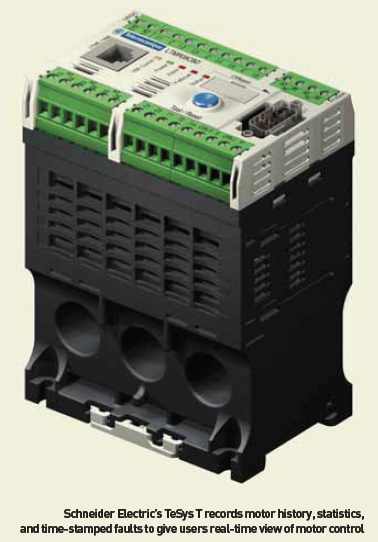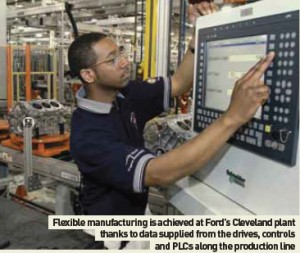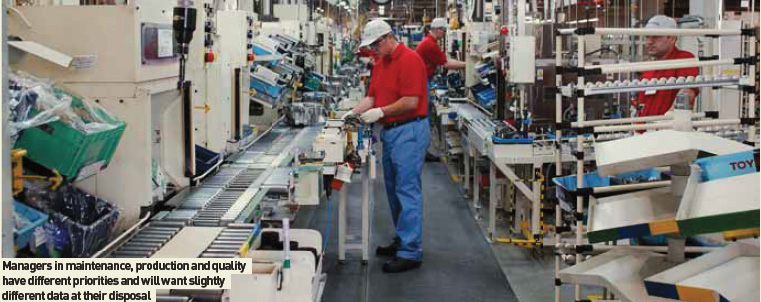
Information is crucial in today’s lean manufacturing environment, but the amount of data generated by resource planning software can often be bewildering and even counter productive. AMS looks at why it’s important to filter the facts and use data intelligently to drive production
Despite the advances over recent years with machine tool technology, it is control software and machine automation that is now driving productivity in the automotive sector. Increased running speeds, improved tool change and the addition of extra spindles pale in significance when compared to the gains achieved by analysing all the data supplied from the drives, controls and PLCs along the production line. That said, businesses are buried in data. To begin with, each has a financial reporting system while many also have sophisticated enterprise resource planning (ERP) systems to handle production and manage inventories. Some collect manufacturing and quality data electronically for compliance or control issues. A few may have a Computer Maintenance Management System (CMMS), managing spare parts and dispatching resources. Computers throughout the company are full of home-grown spreadsheets and databases, tracking metrics related to a department or an individual’s responsibility.
 Since sources are not always integrated, data can often have discrepancies, redundancies and omissions. Each data source may have limited access for political, compliance or other security reasons. Sometimes data is only available in raw number form, distributed on several reports and screens. Is it any wonder management teams find it difficult to agree on potential investments or process improvements?
Since sources are not always integrated, data can often have discrepancies, redundancies and omissions. Each data source may have limited access for political, compliance or other security reasons. Sometimes data is only available in raw number form, distributed on several reports and screens. Is it any wonder management teams find it difficult to agree on potential investments or process improvements?
Just the facts
Successful data harvesting is only the first step in producing useful information. Integrating business, quality, production and maintenance systems with powerful analysis capability is key for most businesses, providing one insightful version of the facts. Data can then become information that drives action, justifying and prioritising investments.
“Everybody may have an idea about what the problem is, but in practice, it rarely is what they think it is,” says Mark Brownhill, Product Manager for GE Fanuc’s Proficy Machine Tool Efficiency (MTE) product. “If you don’t collect data to decide where your biggest opportunity is for the least investments, you are simply not going to make as much progress as you should. So it’s the old assumptions thing – if you assume what the problem is you can spend a lot more time implementing solutions that are just not going to give you the return that you expect.”
Most people can spot patterns in graphical data faster and easier than they can in tabular data. As renowned statistician Ellis Ott states: “Plot the data, because the picture of the data tells you something.” Though statisticians prefer variable data, there is an incredible amount of attribute data in manufacturing. The Pareto is one of the most useful tools for attribute data. Numbers are simply put in order and displayed in a graphical bar chart. The Pareto quickly provides information on worst and best case data.
There are numerous ways to ‘plot’ data and each method may tell you something different. Line charts, bar charts, pie charts, XY plots, time series charts and other common graphical elements each have their strengths and weaknesses, depending on the purpose or type of data being analysed. For example, it is difficult to visually compare the contents of two pie charts, and two stack percentage bar charts are preferred.
Statistical control charts, histograms, Paretos, C, Np, and U charts, and correlation charts are useful for analysing all data, and their application is not limited to the quality department. For example, a correlation chart aids in finding relationships between data sets for root cause analysis.
Mining for information
Resources are wasted in most companies producing stovepipe data analysis because corporate systems are focused on financial analysis and inventory management, not operational excellence. The financial data is very sensitive, so enterprise systems reasonably limit access. ERP systems are very complex and a user must go through extensive training to become proficient at data mining. It can be difficult to mine data from corporate systems. It is often provided on multiple screens or reports. Creating custom displays or reports requires specialised programming skills and security authorisations. Requests for IT to produce custom reports for a single department or individual cannot compete with the needs of multiple users that can deliver a higher potential return on investment.
Some businesses have recognised the problem and have created data warehouses to provide easier access to critical operational data, but these are often focused on customer self-service or sales-related issues. However, little valuable data is available for manufacturing. The material push modules of most ERP systems are not as valuable in today’s just-in-time, high-volume, high-mix production systems. They typically create production requisitions and manage finished goods inventory, while totally ignoring the operational details between the two events.
Operator and process practices
Purpose-built manufacturing applications are rarely integrated with the ERP system. Requisitions are printed and entered manually into the manufacturing system, or electronically copied and pasted. Finished goods inventory is keyed back into the ERP system at the end of the manufacturing cycle.
“If you have several machines doing similar kind of work, you would expect them to have similar OEE performance. In practice, however, you find that they don’t,” Brownhill adds. “Some machines will stand out as exceptional and some will stand out as being a problem. Most of it is to do with the operator and process, not the equipment itself. On a day-to-day basis, manufacturing data is stored in individual and departmental spreadsheets and ad-hoc databases. Each department has its own metrics. Whether it is machining, fabrication, welding, finishing, quality or maintenance – each documents its own performance in separate systems. The data is typically collected and entered manually, together with all the expected data-entry errors and departmental and individual biases.
In this environment, meetings intended to focus on improving operations often simply spend time trying to understand the data, with debates centering on the small differences between the stove-pipe data, rather than on the common ground.
 Patterns with raw data
Patterns with raw data
Still, if all data was integrated into a single system, it would be even more overwhelming. Identifying patterns and correlations in millions of rows, multiple columns of numbers and pages of text fields is not practical. The raw data needs to be turned into actionable information. “We have a program that you can use in the classic manner that looks a lot like a relay diagram; it’s virtually built for the electrical maintenance personnel,” explains John Boville, Automotive Segment Manager at Schneider Electric North America. “You can program it in a lot of other languages as well, such as logic.
“The actual application programming is usually done by the person that manufactures the machines. Bear in mind that it is a challenge in that on a typical engine project, you would have 25-30 OEMs all around the globe doing their own thing. We can bring expertise that develops software tools and standards that allow consistency in design. So we would be able to issue these things to the OEMs so they can be assembled into the final application programmes. So our software is more of a programming tool.”
All kinds of data
Manufacturing Information Portals or Factory Intelligence Systems are designed to integrate data from a wide range of distributed systems. They then turn the data into actionable information by using advanced analytics and visualisation tools.
“We have such in-depth data collection for the machine tools that we can tell you what program was running, how long it ran and what the shortest time was that the program ran on any machine; we can give you all kinds of data,” Brownhill adds. “We can tell you the mean time between feed failure and probably more importantly, the mean time to repair – how quickly you recover from down time. That is where so much is lost in manufacturing – from the recovery times. It’s not the fact that the error occurred, but more to do with the fact that people don’t have stable recovery processes. Tooling is missing. How do I get that tooling here at this machine?
It is very complicated but this in-depth analysis can compare machines, compare plants, compare shifts or operators, you can do all kinds of comparisons. You can get the data to tell you your top ten downtime problems, your top ten performance problems, so it gets you focused on the things that will give you the biggest impact.” But what are some of their important characteristics?

User relevance
Perhaps the most important way that data can be turned into information is to make the relevant data immediately available to the user. That means that the user should not have to navigate through multiple screens to find the key metrics important to the process.
There are at least two aspects to relevance and these are both contingent on a person’s role in the organisation. The first is the amount of detail that is displayed depending on a person’s level of responsibility. For example, a plant manager may want an overview of how each line is doing, whereas the line manager may want an overview of each machine in the line.
The second dimension depends on a person’s departmental role within the organisation. Managers in maintenance, production and quality have different priorities and will want slightly different data displayed, at least initially. Information portals allow role-based information to be displayed, selecting different data sets depending on an individual’s login credentials. The pieces of information displayed are intelligent ‘web-parts’, allowing the individual user to customise their environment by moving the pieces around on the screen, and by adding or dropping elements or data sets according to their needs.
 Comparative analysis and benchmarking
Comparative analysis and benchmarking
When looking at information, it is natural to look first for problems. Information viewed in a single context, however, may not provide the complete picture; all data must be examined to get thorough insight.
For example, a production throughput chart for several machines processing similar parts over a three-shift period would likely show a normal distribution. Most of the machines would have similar output, with one having a higher-than-average output and another with lower-thanaverage output. The process of aggregating data tends to smooth results. We are naturally drawn to the under performing asset, but even if we bring the performance of the one machine up to the level of the average machine, it has limited impact on overall results.
Comparative analysis looks at the data from multiple points of view to offer more insight. Comparing the data by shifts may uncover problems on third shift, or it may surprise you, and certain machines may actually perform better without supervisory interruptions. Comparing the data by part number may show that certain parts are more difficult to process, perhaps breaking more tools, or identifying material shortages from upstream processes. Comparing the machines by manufacturer, model or type may tell you something about the suitability of the equipment. By discovering something that will improve the performance of the average machine, we can make improvements that will have more impact than is possible by focusing on the single, low-performing outlier.
Benchmarking business performance against competitors is a powerful tool. However, benchmarking is also useful within an organisation. “In our example, we anticipated that one machine would be performing better than the average,” Brownhill says. Discovering why is important for process improvement. Comparative analysis can help you pinpoint why the machine is excelling. If it turns out to be related to the performance of the equipment, then you have useful information for your next purchase. If it turns out to be related to personnel or process, you can translate the best practices to the other machines, perhaps with some training or process documentation. Adopting best practices significantly impacts overall performance – without significant investment and at very low risk.
There are two levels of integration: manufacturing integration and enterprise integration. First and foremost, all manufacturing data needs to be integrated. In that way you can trace quality problems back to specific machine, shifts or operators. You can compare the performance of different machines or process producing the same part, useful information when it comes time to purchase additional equipment. You can see the effect that set-up, breakdowns, speed issues, minor stoppages, set-up yields and production yields have on the throughput of the factory. It allows maintenance to perform usage-based preventative maintenance, rather than calendar-based interventions, effectively stretching the budget.Enterprise integration closes the loop with the business systems. Production requisitions and finished goods inventory numbers are passed back and forth electronically.
This eliminates manual data entry errors and dwells in the system so that the sales and business teams are working for all intents in real-time. Accurate production data and continuous improvement builds confidence between sales and production, so bigger swings can be taken to grow the business. Some of the equipment in the forming and fabricating industries will be controlled by PLCs. There are several communication standards available including DeviceNet, Profibus, Ethernet and OPC. However, it is possible that not all your equipment will support just one of those standards


































